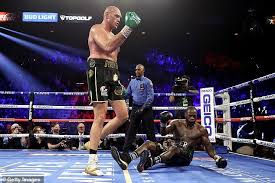If you were to come up with the concept now, the idea of two people standing toe-to-toe and belting each other in the head until both were senseless and one was flat on the floor would only ever be a metaphor for modern political debate.
Yet in a world where we are so determined to eradicate brain trauma that young footballers might soon be banned from heading the ball and car drivers forced to wear helmets while travelling to the local supermarket, boxing somehow survives.
You might even suggest the “sweet science” is prospering if the excitement surrounding the battle for the WBC heavyweight title is any indication.
On Sunday, millions of pay-per-view subscribers and thousands of spectators in Las Vegas exercised their legal right to watch Englishman Tyson Fury and American Deontay Wilder attempt to inflict a blow that would be sufficiently forceful to deprive his opponent of consciousness.
Or, as it transpired, for Fury to land a series of punches to the head and body that convinced Wilder’s corner to throw in the towel in the seventh round, before their man could suffer even greater cranial distress.
This act of surrender was to the apparent disgust of Wilder, who claimed he could have copped even more of his hulking 123-kilogram opponent’s savage blows on the chin.
For boxing aficionados, however, the quaint gesture of tossing a blood-stained towel into the fray forms the first line of defence against claims the sport should be banned.
Like those horse trainers who defended the racing industry against claims of animal cruelty exposed by the ABC on the grounds that they cared for horses more than anyone, boxing is confident in its ability to look after its own — even as they are being brutally pulverised.
Unlike racehorses “encouraged” with whips, boxers are exercising their freedom of choice while being hit in the head and — in the most celebrated cases — earning an astronomical sum to do so.
What’s more, in an era when celebrity often trumps utility, Fury — known as the Gypsy King in honour of his Irish heritage — has the kind of almost-too-good-to-be-true backstory that makes Rocky Balboa look like a silver-spoon-fed kid.
Fury was the sickly baby who was named after another world champion in the hope he would fight for his life with the same tenacity shown by Mike Tyson.
He is the world champion who succumbed to mental health troubles, and alcohol and drug addiction before rising again; the bluff, balding, beefy champ who indulges in the kind of cartoon-book braggadocio boxing fans love.
Fury’s is the kind of story that allows boxing’s proponents to boast that the sport’s strict training regime and fearsome rituals invest it with a special ability to elevate the battler and redeem troubled souls.
Besides, boxing’s still-large fan base might argue that if a man such as Fury can use his natural-born gift for brutality to dismantle those who volunteer to face him while he risks being knocked senseless himself, what right have those PC warriors cowering at the bloody consequences to stop him?
Boxing still enjoys rabid popularity
Yet for all Fury’s made-for-Hollywood appeal and in an era when boxing has become a “special event” rather than a staple of the mainstream sporting diet, the sight of two men landing crushing blows to each other’s heads for the amusement of the ringside observers has become even more incongruous.
We campaign against one-punch violence, urge various sports to curtail the incidence of potentially debilitating concussions and deposit the contents of dented skulls in brain banks to research the impact of the violent collisions endured on the field.
A punch in the head, however, is not merely an unfortunate side-effect of boxing but its topspin forehand, its drop punt, its cover drive — its very essence.
And no, this is not yet another predictable demand that boxing be banned.
It is merely to wonder why — knowing all we do about the impact of head injuries — the sport still enjoys the kind of stupendous popularity that made the Fury-Wilder fight the subject of international obsession.
Boxing’s nostalgic appeal remains strong with even the long-splintered world heavyweight title still somehow exuding the same kind of aura and prestige as track and field’s 100 metres sprint.
Heavyweight champs were the biggest and the boldest; the masters of the sporting universe from Jack Dempsey to Joe Louis to the most luminous of them all, Muhammad Ali.
Although, significantly, such nostalgic yearning does not extend to Ali’s sadly diminished latter-life identity as a shuffling, twitching hulk with the booming voice that contributed so greatly to his sporting immortality muted to a whisper.
For some, boxing no doubt provides a thrilling counterpoint to the supposedly sanitised sport of the “nanny state” era, especially those who are not being mischievously ironic when they yearn for rugby league to “bring back the biff”.
Perhaps the relative scarcity of boxing on our free-to-air screens now also contributes to its survival. Would boxing endure if there was a brighter spotlight shone on the brutal bouts that fill the undercards at bleak suburban venues?
But, most pertinently, boxing is the coal mining of sports. It survives despite itself through the economic reality of supply and demand.
So save your outrage. Like it or not, boxing will endure as long as there are those willing to pay to watch two people punch each other in the head.

